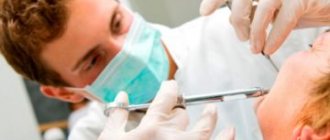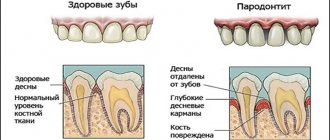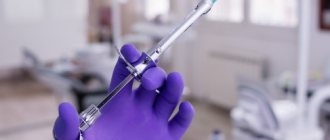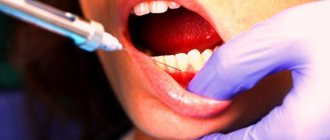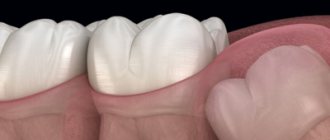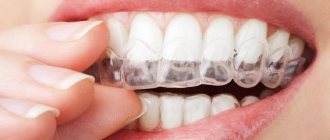Excruciating toothache and other oral problems can occur in every person at the most unexpected moment in life, and pregnant women are no exception. To make dental treatment easier for the expectant mother without harming the baby, modern dentistry is ready to offer local anesthetics that are safe for both. Ultracaine is one of the few drugs that is used in dentistry during pregnancy. It has a rapid analgesic effect, is well tolerated and has no side effects, as it is quickly eliminated from the woman’s body. Is it possible to use Ultracaine during pregnancy, in what dosage is it used, as well as reviews about this drug, this article will tell you.
When is the best time to treat teeth during pregnancy?
Conventionally, the pregnancy period is divided into three periods - trimesters . The first trimester is characterized by the formation of all organs and systems; in the second trimester , their smooth development occurs; in the third trimester , their preparation for independent work or independent functioning occurs.
Each trimester has its own management features - the first and third have the largest number of “critical periods”, so any medical interventions are considered undesirable (of course, except for those that are necessary to preserve the life and health of the mother and baby). The second trimester (this is approximately 14-20 weeks) is the safest, including for dental treatment.
Anesthesia for dental treatment during pregnancy
This situation is also completely natural and does not pose a big problem. Today's anesthetics (these are drugs based on articaine, such as "Ubistezin", "Ultracaine") have an exclusively local effect, without penetrating the placental barrier, which means they are safe for the child, moreover, they have a reduced concentration of vasoconstrictors, and in some they are generally absent (for example, in anesthetics based on mepivacaine).
Ultracaine: has low toxicity, penetrates the placental barrier to a minimal extent, and is practically not excreted in breast milk. If it is necessary to use the drug during pregnancy, preference should be given to Ultracain D-S. If it is necessary to use the drug in a nursing mother, there is no need to interrupt feeding, since the drug is not excreted into breast milk in clinically significant quantities.
Ubistezin : has a low degree of toxicity. The active substances penetrate the placental barrier to a minimal extent and are practically not excreted in breast milk. Insufficient data have been accumulated to fully assess the safety of the use of ubistezin during pregnancy. If it is necessary to use the drug in a nursing mother, there is no need to interrupt feeding, since the drug is not excreted into breast milk in clinically significant quantities.
Septanest: penetrates the placental barrier and, although there is currently no data on its toxic effects, the use of this drug during pregnancy and lactation should be excluded.
Many expectant mothers are very afraid of x-rays , and many dentists prefer to leave the treatment of such a tooth “for later.” In general, x-rays are contraindicated before the 20th week of pregnancy. Believe me, nothing bad will happen from one photograph taken with all precautions (lead protection on the stomach - the so-called lead apron), and will be an excellent help in dental treatment. In modern radiovisiographic devices, the radiation dose is reduced tens of times, and the quality of the images is not inferior to film ones.
If the doctor has concluded that the tooth cannot be saved, it must be removed, which is a surgical operation, but even this does not present any difficulties during pregnancy. The operation takes place under local anesthesia. It is important to strictly follow all the doctor’s recommendations (under no circumstances rinse, do not heat the surgical area, etc.) to avoid complications.
A special case with “wisdom teeth” . Their removal often requires additional surgical procedures and further prescription of antibiotics. Therefore, it is better to postpone this procedure, if possible.
There are no contraindications to prosthetics during pregnancy. As a rule, procedures performed by an orthopedic dentist are safe and painless, and the expectant mother has free time to take care of the beauty of her smile.
But you should forget about implantation for now, since the period of engraftment of implants requires large expenses from the body, and the expectant mother needs them for the development of a healthy baby. In addition, implant healing often takes place under the influence of medications that reduce the body’s reactivity, and this is also an absolute contraindication during pregnancy.
Perhaps gingivitis (inflammation of the gums) is the most common complaint of women, starting from 3-4 months of pregnancy. This is due to serious hormonal changes throughout the body. It is typical that in the first half of pregnancy there is a mild form (the so-called catarrhal gingivitis), and in the second half the course of the disease is more severe, often with the growth of gum tissue (the so-called hypertrophic gingivitis). In the initial stage of gingivitis, the edge of the gum becomes bright red, swells, and bleeds easily. Gradually, such gums become dark red or even bluish and increase in size.
Treatment of mild forms of gingivitis consists of antiseptic treatment of the gums, professional teeth cleaning (this removes traumatic and infectious factors), and the appointment of applications or rinses with anti-inflammatory drugs. As a rule, after childbirth, all symptoms of mild gingivitis disappear without a trace.
If there is an overgrowth of gum tissue , then they are removed surgically without harm to the health of the expectant mother and child.
Taking medications, dosages, duration of use must be agreed with your doctor. Because there may be certain conditions and chronic diseases in the mother's body that may make these drugs less safe than they are, for example, for a healthy pregnant woman.
So, can pregnant women take an antibiotic, and what antibiotics can pregnant women...
When treating pregnant women, the drugs of choice are beta-lactam antibiotics, for example, the penicillin group. In table No. 1 you will see a list of the safest antibiotics (safety category “B”).
Antibiotics are prohibited : tetracyclines and fluoroquinolones . With caution (not advisable, but in some cases necessary) - sulfonamides and some representatives of aminoglycosides . Before starting antibiotics, it is best to discuss this with your obstetrician-gynecologist.
When deciding whether to prescribe a drug to a nursing woman, the doctor takes into account:
→ indicator of drug toxicity,
→ dose and duration of taking the drug,
→ age of the breastfed child,
→ volume of milk consumed,
→ effect of the drug on lactation.
Concerns of doctors and patients
A survey of 702 private dentists in Germany showed that only 61% of them treat pregnant patients, 35.5% postpone treatment until the postpartum period, and 3.5% refer them to other clinics. Only 10% of dentists perform all necessary types of treatment, 14% refuse local anesthesia. Almost half of the dentists indicated that they would not treat in the first trimester, and 8.5% - in the second.1
In a survey of 116 dentists in Connecticut, USA, 97% of dentists said they had treated pregnant women, but only 45% felt comfortable doing so.2
Seeking a consultation with a gynecologist does not clarify the situation much. A survey of 138 obstetricians in North Carolina, USA, found that 49% rarely or never recommend dental examinations to patients.3
Women themselves have little idea of the risks of refusing treatment during pregnancy. In a 2012 survey, two-thirds of Australian women said they did not seek dental care during pregnancy, even if they had problems.4
Ways to reduce exposure of medication to your baby's milk
- temporary cessation of feeding,
- refusal to feed the child during peak concentrations of the drug in the blood plasma (in this case, consultation with a doctor is necessary, because without him you will not understand what’s what),
- taking the drug during the child’s longest sleep.
What antibiotics can be used by pregnant and lactating women , as well as painkillers and injections for dental treatment are listed in Table No. 1.
Table 1 - Choice of medication in dentistry during pregnancy and lactation (injections for
dental treatment)
| Medicine | Risk categories during pregnancy | Risk categories during lactation |
| Local anesthetics | ||
| Lidocaine Mepivacaine | B (possibly) C (undesirable) | Safely Safely |
| Analgesics | ||
| Paracetamol | B (possibly) | Safely |
| Ibuprofen | B (possibly in the 1st, 2nd trimester) D (absolutely not allowed in the 3rd trimester) | Safe |
| Antibiotics | ||
| Penicillins | B (possibly) | Safe |
| Cephalosporins | B (possibly) | Safe |
| Clindamycin | B (possibly) | Safe |
| Metronizazole | B (possibly) | Safe |
How to choose the optimal anesthetic?
1. First, you need to decide whether pain relief is really necessary. Many dental procedures are painless or slightly painful. Professional teeth cleaning, treatment and prosthetics of pulpless teeth, in some cases, treatment of caries or wedge-shaped defects in living teeth are unpleasant, but often it is quite possible to endure them without experiencing unbearable suffering. Therefore, it is recommended to try this safest approach. If serious pain occurs, there is no need to torture yourself - it is wiser to agree to local anesthesia.
Cosmetic procedures (teeth whitening, installation of veneers) are completely inappropriate during pregnancy - they can and should be postponed.
2. From the entire range of anesthetics, in the absence of contraindications, it is preferable to choose 4% articaine with adrenaline 1:200,000. Articaine, although it has category C according to the FDA classification, is safer than other anesthetics. Its teratogenic effect was discovered when laboratory rabbits and rats were given loading doses of 4% articaine in combination with 1:100,000 adrenaline (2-4 times the maximum permissible concentration for humans). When using drugs at the level of the maximum permissible concentration for humans, no teratogenic effect was detected in experimental animals.20 Moreover, the concentration of 1:200,000 is half as low, and no one will use 7 carpules at a time (the maximum permissible volume) in pregnant women.
3. If such anesthesia turns out to be ineffective, then it is better to use the second carpule with a ratio of 1:100,000 articaine and adrenaline. The chances of achieving deep pain relief are significantly increased.
4. If adrenaline is completely contraindicated or significantly increases the risk of complications (arterial hypertension, paroxysmal ventricular tachycardia, atrial fibrillation, bronchial asthma, hyperthyroidism, pheochromocytoma, etc.), then you need to use 3% mepivacaine without adrenaline.
5. It is acceptable to use lidocaine with an adrenaline concentration of 1:200,000 or 1:100,000 for pregnant women. Lidocaine has category B. However, the effectiveness of its anesthesia is 1.5 times less than that of articaine.21 And the risk of allergic reactions is higher (up to to anaphylactic shock).
Anticonvulsants
Carbamazepine (Finlepsin, Mazepin, Carbapine), Phenobarbital, Phenytoin
Various fetal malformations. Predisposition to bleeding in newborns, which can be prevented by giving vitamin K to the pregnant woman a month before giving birth.
Pregnant women CAN antibiotics from the group of semisynthetic penicillins, macrolides and most cephalosporins according to indications and as prescribed by a doctor . During pregnancy, it is strictly forbidden to use antibiotics from the group of tetracyclines and aminoglycosides, as they have a damaging effect on the fetus and can cause damage to the hearing organ, tooth buds and bone tissue.
Trimethadione (Trimethin, Ptimal)
Increased risk of miscarriage. High risk of having a child with gross malformations (heart, facial skeleton, hands, etc.)
Valproate (Convulsofin, Depakine)
Low risk of malformations of the heart, limbs, and internal organs.
Antihypertensives (drugs that lower blood pressure)
ACE inhibitors (Captopril, Ramipril, Enalapril, etc.)
Taking shortly before birth increases the risk of kidney damage in the child, a decrease in the amount of amniotic fluid and the development of defects of the facial skeleton, limbs, and lungs.
The use of aminoglucoside antibiotics (neomycin, kanamycin, monomycin, gentamicin, etc.) and tetracyclines during pregnancy is absolutely contraindicated.
Levomycin, erythromycin, ristamycin, and fusidine also have a bad effect on the baby. Corticosteroids and antiepileptic drugs are very harmful: they can cause a child to be born with a wide range of deformities. Even if they are minor, it will still be a tragedy.
The fetus can excrete the drug through the kidneys through urine into the amniotic fluid, but the harmful substance can then be reintroduced to the fetus through ingestion.
In the early stages you should absolutely not take : Warfarin. Diethylstilbestrol. Androgens. Antitumor agents. Corticosteroids (high doses). Fibrinolytic drugs. Tetracyclines. Valproate Vitamin A analogues. Cyproterone acetate. Distigmine. Misoprostol. Amiodarone. Chloroquine. Lithium. Phenytoin. Calcium antagonists, griseofulvin, omeprazole, quinolone antibiotics, rifampicin, spironolactone, live vaccines.
Taking oral contraceptives in early pregnancy increases the risk of chromosomal abnormalities and the risk of having children with Down syndrome.
In the second half of pregnancy it is not recommended to use : Aspirin. Aminoglycosides. Aminoglycosides. Tetracyclines. Levomycetin. Sulfonamides and novobiocin. Anticoagulants. Thiazide diuretics. Benzodiazepines. Sulfonylurea. Disopyramide. Misoprostol. Fibrinolytic drugs. Narcotic analgesics. Nitrofurantoin. Non-steroidal anti-inflammatory drugs. Antithyroid drugs. Reserpine.
In the last weeks of pregnancy and during childbirth, medications have less effect on the baby.
This does not mean that there is no need to treat illnesses during pregnancy. You just need to treat treatment during this period of life responsibly and carefully.
